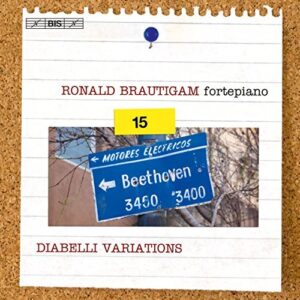Ronald Brautigam brings his solo Beethoven cycle for BIS to a triumphant conclusion with the long-awaited Diabelli Variations, in one of its finest recordings ever. My late colleague Harris Goldsmith wrote about three basic interpretive approaches to the Diabellis. One is cumulative, by way of linking the variations and creating an overall arc. The second approach treats each variation as a separate entity in and of itself, while the third mainly concerns itself with virtuoso display and surface bravura.
The cumulative approach presents the most challenging yet satisfying option, as revealed by pianists like Artur Schnabel, Rudolf Serkin, Claudio Arrau, Charles Rosen, Stephen Kovacevich, Daniel Shapiro, and now Ronald Brautigam. A steady yet never rigid basic pulse appears to anchor Brautigam’s seemingly interrelated tempos. Some of them may strike listeners as uncommonly fast, such as in Variation Four, where the music’s lyrical nature often causes pianists to take Beethoven’s Un poco più vivace marking with a grain of salt. Brautigam’s animation, however, does not preclude a subtle degree of inflection. No. 5’s repeated notes boast wonderful rhythmic spring, while Brautigam avoids clunkiness in No. 9’s gruff pesante phrases by getting the accents perfectly aligned.
You rarely hear No. 10’s broken chords and dashing octaves so nimbly tossed off yet so melodically informed, and the same goes for the broken octaves in Nos. 16 and 17. The spiraling arpeggios in Nos. 19 and 27 manage to be punchy and angular at the same time. To be sure, Andreas Staier’s fortepiano Diabelli recording allows for more breathing room and repose in the slower variations, plus extra humorous abandon in No. 22 (based on Mozart’s Notte e giorno faticar from Don Giovanni) and the famous “bang…..scamperscamperscamper” No. 23 (abetted by an instrument sporting percussion effects).
On the other hand, the McNulty replica of a Graf fortepiano model circa 1822 that Brautigam uses holds its tuning more dependably, and projects more powerfully, at least under the studio microphone’s scrutiny; the highly defined levels of articulation in No. 32’s difficult to voice fugal textures is a tribute both to the instrument’s specifications and Brautigam’s focused fingerwork. Brautigam follows Op. 120 with a solo piano arrangement of Beethoven’s Op. 105 variations for flute and piano, an admittedly lightweight coupling, yet it helps one decompress after such a gratifying Diabelli experience.
No single release can do total justice to this work’s vast dimensions, and indeed Brautigam’s interpretation will not cause fortepiano mavens to forgo the singular insights of the Staier and András Schiff versions. However, Brautigam’s mindful virtuosity, his architectural astuteness, and his thorough immersion into Beethoven’s style add up to a crowning achievement.
































